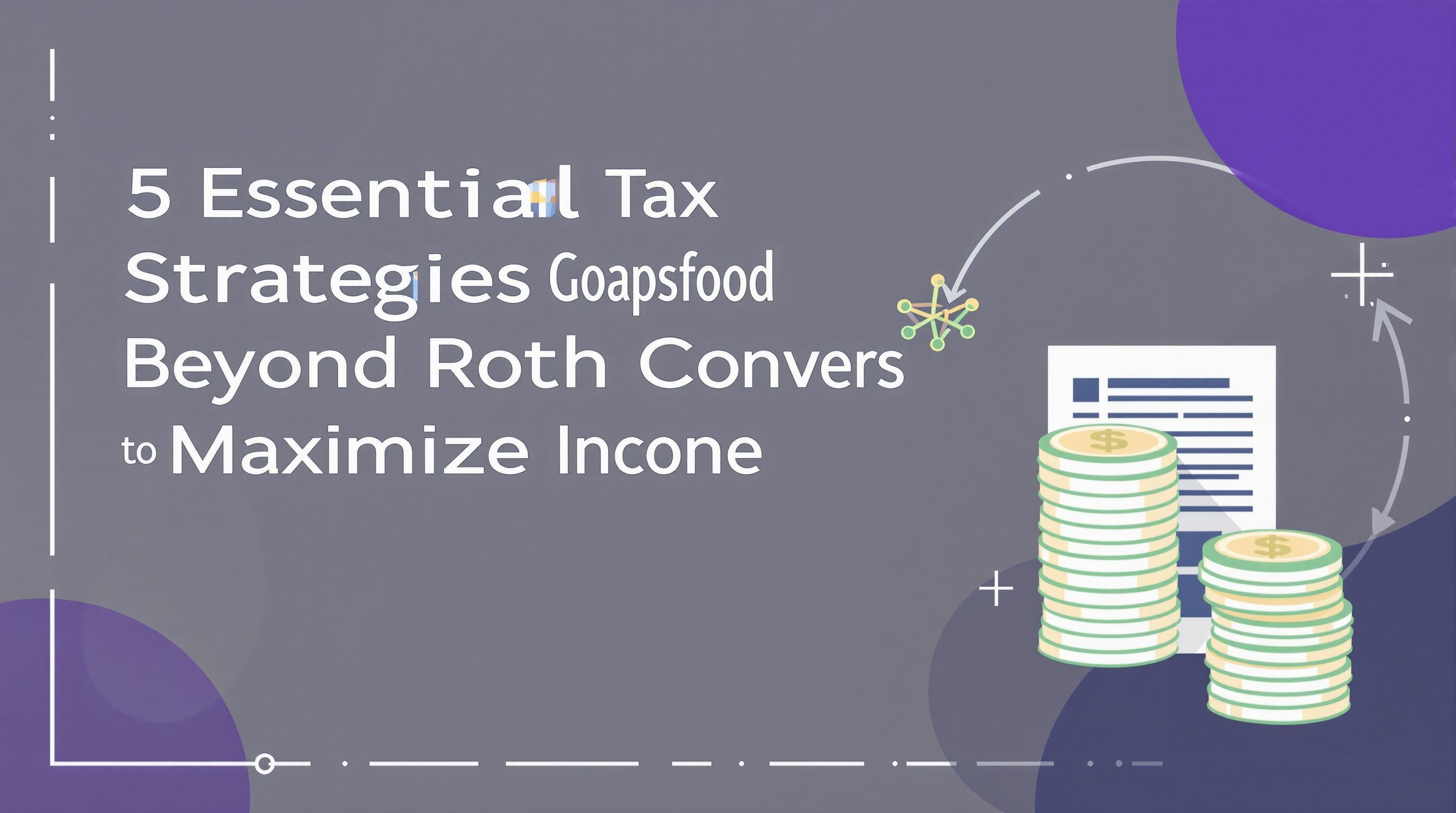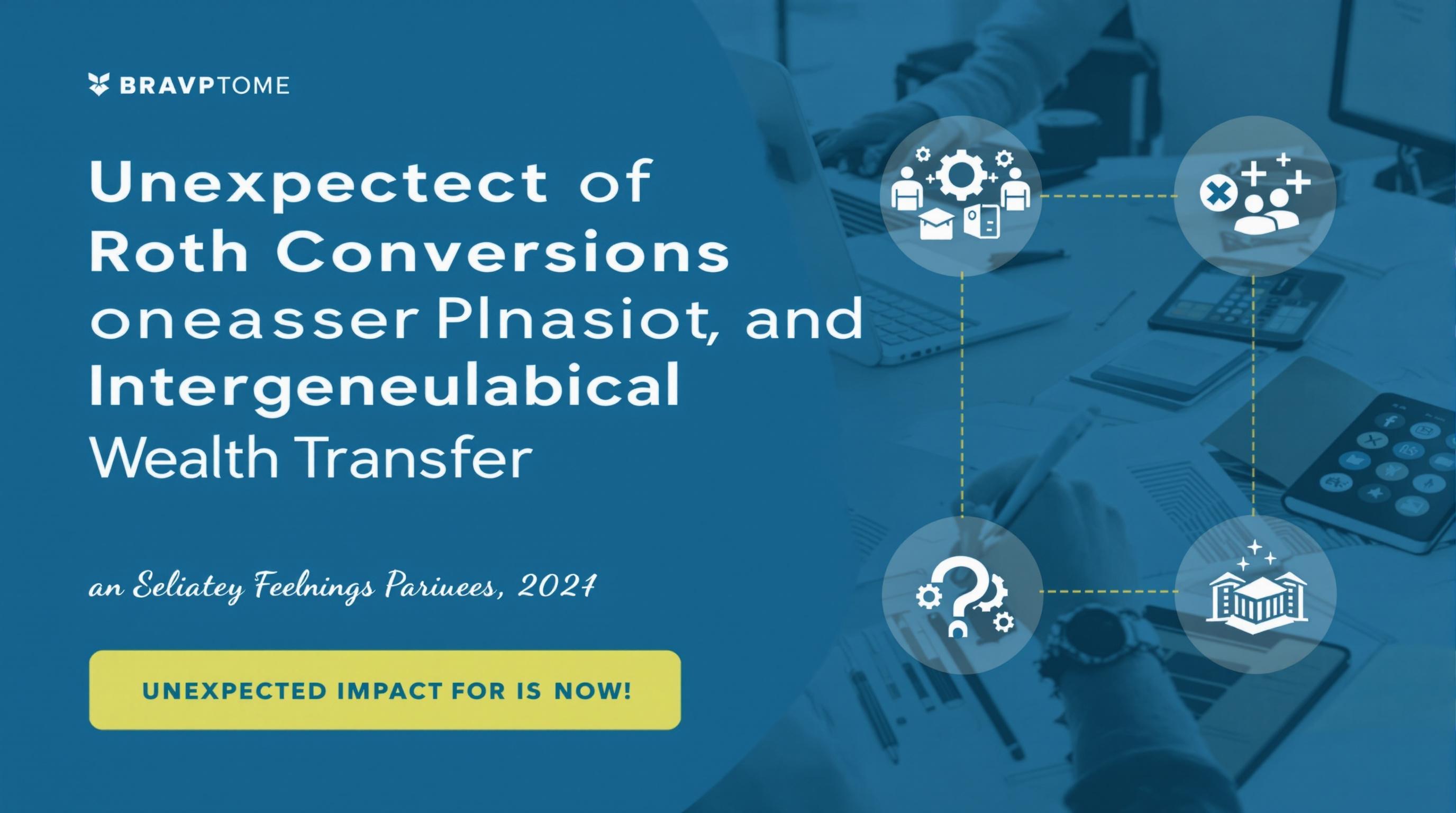Related Articles
- 8 Emerging Robo-Advisors from the Last Five Years That Redefine Smart Portfolio Allocation
- 6 Groundbreaking Thematic ETFs Launched Since 2019 That Disrupt Conventional Portfolio Mixes
- 7 Unconventional ETFs Launched Since 2019 That Revolutionize Portfolio Diversification Strategies
- Exploring the Role of Digital Nomadism in Crafting Sustainable Earnings After Traditional Work Ends
- Top 6 Underrated Retirement Income Solutions Released Since 2019 That Outsmart Traditional Options
- How Niche Hobby Investments Could Reshape Risk Management in Unconventional Financial Strategies
5 Essential Tax Strategies Beyond Roth Conversions to Maximize Retirement Income Streams
5 Essential Tax Strategies Beyond Roth Conversions to Maximize Retirement Income Streams
5 Essential Tax Strategies Beyond Roth Conversions to Maximize Retirement Income Streams
While Roth conversions are a popular strategy for managing retirement taxes, savvy retirees and pre-retirees can benefit from a broader toolkit of tax strategies. Understanding and implementing these approaches can help maximize income streams and reduce the tax burden over the course of retirement. This article explores five essential tax strategies beyond Roth conversions that are critical for anyone looking to optimize their financial future.
Each section below delves into a specific strategy, its benefits, and practical considerations to help you make informed decisions. These approaches are grounded in tax law awareness and retirement planning best practices.
Let’s begin by exploring the importance of tax-efficient withdrawal sequencing.
1. Tax-Efficient Withdrawal Sequencing
Tax-efficient withdrawal sequencing involves the strategic order in which you take distributions from various retirement accounts like traditional IRAs, Roth IRAs, and taxable investment accounts. This strategy aims to minimize your taxable income each year, allowing your investments to grow more tax-deferred over time.
Typically, financial advisors suggest withdrawing from taxable accounts first, then tax-deferred accounts, and finally from Roth accounts. This approach maximizes tax-free growth potential within Roth IRAs and delays triggering taxable events. However, individual circumstances may require tailored plans based on income needs and tax brackets.
By carefully planning the withdrawal sequence, retirees can reduce the overall taxes paid during retirement, potentially preserving more wealth. For detailed guidelines, review IRS rules on Required Minimum Distributions (RMDs) and consult tailored advice from certified financial planners.
2. Utilizing Tax-Loss Harvesting to Offset Gains
Tax-loss harvesting is a strategy used to reduce current-year tax liability by offsetting capital gains with realized investment losses. This is particularly useful for investors with sizable taxable investment accounts.
When you sell securities at a loss, these losses can be applied against gains to reduce taxable income. If losses exceed gains, up to $3,000 of the excess loss can offset ordinary income annually, with the remainder carried forward indefinitely under IRS rules.
Implementing tax-loss harvesting requires careful portfolio management to avoid the wash-sale rule, which disallows losses if you purchase the same or substantially identical security within 30 days. When utilized correctly, it can effectively manage taxes and improve after-tax returns in retirement.
3. Strategic Charitable Giving via Donor-Advised Funds
For retirees interested in philanthropy, donor-advised funds (DAFs) provide a tax-advantaged way to manage charitable giving. DAFs allow you to make a charitable contribution today, get an immediate tax deduction, and recommend grants to charities over time.
This approach helps manage income by potentially bunching charitable contributions into one year to surpass standard deduction limits and reduce taxable income. It also offers flexibility in timing donations and investment growth inside the fund is tax-free.
Charitable giving through DAFs can be especially powerful if combined with distributions from IRAs, allowing for tax-efficient giving strategies. The IRS also allows Qualified Charitable Distributions (QCDs) from IRAs after age 70½, which can satisfy RMD requirements without adding taxable income.
4. Taking Advantage of Health Savings Accounts (HSAs)
While often overlooked, Health Savings Accounts (HSAs) are a triple-tax-advantaged tool that can significantly enhance retirement income planning. Contributions to HSAs are tax-deductible, earnings grow tax-deferred, and qualified medical withdrawals are tax-free.
Retirees can use HSAs to cover medical expenses in retirement without incurring a tax burden. Additionally, after age 65, HSA funds can be withdrawn for any purpose without penalty, though non-medical withdrawals are taxed as ordinary income, making HSAs a supplementary retirement account.
Maximizing contributions during working years, investing the HSA funds, and using them strategically in retirement can reduce healthcare costs and taxable income. Understanding the rules and contribution limits is crucial, as outlined by the IRS Publication 969.
5. Managing Social Security Income Tax Efficiency
Social Security benefits can be taxable depending on your combined income — a calculation that includes adjusted gross income, tax-exempt interest, and half of your Social Security benefits. Up to 85% of benefits can be taxed for higher income brackets.
To manage this, retirees can consider delaying Social Security benefits to increase monthly payments and reduce taxable income early in retirement. Coordinating withdrawals from retirement accounts around Social Security claiming strategies can minimize taxes on those benefits.
Proper planning may also involve managing income sources to keep provisional income below thresholds that trigger higher Social Security taxation. For this, consulting IRS guidelines and Social Security Administration resources is advised to create a tax-efficient retirement income plan.
6. Using Qualified Longevity Annuity Contracts (QLACs)
Qualified Longevity Annuity Contracts (QLACs) offer an innovative solution to manage Required Minimum Distributions (RMDs) and guarantee income later in life. A QLAC allows you to use a portion of your traditional IRA or 401(k) funds to purchase an annuity that begins payouts at an advanced age.
By investing up to $145,000 (in 2024 limits) into a QLAC, you can significantly reduce your RMDs in earlier years, thus lowering your taxable income and preserving other assets. It also provides a steady income stream starting between ages 70 and 85, addressing longevity risk.
QLACs are subject to specific IRS rules, and they are not suitable for all retirees. Proper structuring and professional guidance can maximize their tax advantages and income security benefits.
7. Leveraging Tax-Free Municipal Bonds
For investors seeking tax-efficient income, municipal bonds can be a noteworthy component of a retirement portfolio. Interest earned on most municipal bonds is exempt from federal income tax, and if issued within your state, it may also be exempt from state taxes.
This tax advantage means that, particularly for retirees in higher tax brackets, muni bonds can offer attractive after-tax yields compared to taxable bonds. Incorporating them can reduce your overall taxable income without sacrificing income generation.
Investors must assess credit risk and interest rate sensitivity but including municipal bonds strategically can diversify income streams and enhance tax efficiency in retirement.
8. Consider Income Shifting Through Family Gifting
Income shifting involves transferring assets to family members in lower tax brackets to reduce the overall family tax burden. This can be accomplished through gifting appreciated assets or establishing family trusts.
By gifting assets, retirees can remove future appreciation from their estate and potentially reduce RMDs and taxable income. Caution is advised to comply with IRS gift tax rules and to consider the long-term effects on control and financial security.
Properly implemented, income shifting can serve both tax planning and legacy goals, creating a family financial strategy that leverages tax brackets and exemptions effectively.
9. Utilizing Tax Credits and Deductions Specific to Seniors
Various tax credits and deductions are available to seniors that can reduce taxable income and overall tax liability. For example, the IRS offers the Credit for the Elderly or Disabled for qualified individuals, which can provide a modest tax reduction.
Other deductions include higher standard deductions for those over 65, deductions for medical expenses, and potential state tax benefits depending on residency. Identifying and utilizing these can help retirees lower their taxable income without complex strategies.
Staying informed on changing tax laws and consulting tax professionals annually ensures that you don’t miss out on these valuable tax breaks, amplifying the effectiveness of your retirement income plan.
10. Planning for State Tax Implications of Retirement Income
Retirement income tax rules vary widely between states, affecting how much tax you pay on pensions, IRAs, Social Security, and investment income. Some states have no income tax, while others tax all or some retirement income components.
Considering relocation or managing where taxable income is recognized can have a substantial impact on retirement income. Careful state tax planning may involve timing income recognition, understanding state-specific deductions, and even weighing the benefits of interstate retirement residency.
Consult state tax codes and professional advisors who specialize in multi-state tax issues to craft a strategy that complements your overall retirement income plan.
Sources:
IRS.gov – Required Minimum Distributions and Qualified Charitable Distributions
Fidelity.com – Tax-Efficient Withdrawal Strategies
Investopedia.com – Tax-Loss Harvesting
SSA.gov – Social Security Benefits Taxation
Treasury.gov – Qualified Longevity Annuity Contracts (QLACs)




